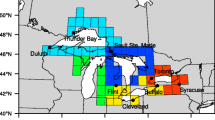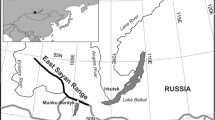Abstract
The runoff generated by snow cover ablation dominates regional hydrology in the North American Great Lakes basin, while rapid events can represent a physical hazard due to flooding. In determining the likelihood and magnitude of an ablation event, both the presence of snow cover and the synoptic-scale atmospheric environment should be considered, where the atmospheric environment provides the meteorological characteristics and surface energy fluxes necessary for ablation. Pending snowpack availability, variations or changes in the frequency of ablation-inducing synoptic types, and/or varying suitability of meteorological characteristics for snowmelt, can alter the frequency of ablation events. In light of a changing global climate, it is unclear if and how ablation-inducing synoptic types in the Great Lakes basin have transformed in recent decades as from 1960 to 2009, the interannual frequency of snow cover ablation events in the Great Lakes basin has significantly decreased. This study uses synoptic classification as a mechanism for identifying ablation-inducing synoptic weather types and for determining if changes to the frequency and inherent meteorological characteristic of the type are occurring. For a majority of the ten most impactful ablation-inducing synoptic weather types examined, significant trends are noted in their interannual frequencies, which can be partially explained by variations and trends in the phases of common teleconnection indices, such as the North Atlantic and Arctic Oscillations. Collectively, inherent meteorological characteristics of particular weather types in the basin are becoming more suitable for ablation, with increases in surface air temperatures, more southerly wind flow, and less cloud cover, plus increases in liquid precipitation rates during rain-on-snow synoptic types. Independent of snow cover, atmospheric environments suitable for ablation are becoming more frequent and generally more favorable for ablation.



Similar content being viewed by others
Data availability
Snow data used in this study are publicly available at the National Snow and Ice Data Center, Mote et al. (2018), https://nsidc.org/data/g10021.
References
Archer CL, Brodie JF, Rauscher SA (2019) Global warming will aggravate ozone pollution in the U.S. Mid-Atlantic. J Appl Meteorol Climatol 58:1267–1278. https://doi.org/10.1175/JAMC-D-18-0263.1
Barnett TP, Adam JC, Lettenmaier DP (2005) Potential impacts of a warming climate on water availability in snow-dominated regions. Nature 438:303–309
Barnston AG, Livezey RE (1987) Classification, seasonality and persistence of low-frequency atmospheric circulation patterns. Mon Weather Rev 115:1083–1126
Braaten RO (1996) An updated Canadian snow depth database. Contract report prepared for Atmospheric Environmental Service, September 1996, 24 pp
Changnon SA (2008) Assessment of flood losses in the United States. J Contemp Water Res Educ 138:38–44
Dyer JL, Mote TL (2006) Spatial variability and trends in observed snow depth over North America. Geophys Res Lett 33(16)
Dyer JL, Mote TL (2007) Trends in snow ablation over North America. Int J Climatol 27:739–748
Ellis AW, Leathers DJ (1996) A synoptic climatological approach to the analysis of lake-effect snowfall: potential forecasting applications. Weather Forecast 11:216–229
Ellis AW, Marston ML, Nelson DA (2018) An air mass-derived cool season climatology of synoptically-forced Appalachian cold-air damming. Int J Climatol 38:530–542
Grundstein AJ, Leathers DJ (1999) A spatial analysis of snow-surface energy exchanges over the northern Great Plains of the United States in relation to synoptic-scale forcing mechanisms. Int J Climatol 19:489–511
Higgins RW, Leetmaa A, Xue Y, Barnston AG (2000) Dominant factors influencing the seasonal predictability of U.S. precipitation and surface air temperature. J Clim 13:3994–4017
Kalkstein LS, Corrigan P (1986) A synoptic climatological approach for geographical analysis – assessment of sulfur dioxide concentrations. Ann Assoc Am Geogr 76:381–395
Kalkstein LS, Tan GR, Skindlov JA (1987) An evaluation of three clustering procedures for use in synoptic climatological classification. J Clim Appl Meteorol 26:717–730
Kalkstein LS, Dunne PC, Vose RS (1990) Detection of climatic-change in the western North-American Arctic using a synoptic climatological approach. J Clim 3:1153–1167
Kalnay E et al (1996) The NCEP/NCAR 40-year reanalysis project. Bull Am Meteorol Soc 77:347–470
Leathers DJ, Yarnal B, Palecki MA (1991) The Pacific/North American teleconnection pattern and United States climate. Part I: Regional temperature and precipitation associations. J Clim 37:4962–4971
Leathers DJ, Kluck DR, Kroczynski S (1998) The severe flooding event of January 1996 across North-Central Pennsylvania. Bull Am Meteorol Soc 79:785–797
Leathers DJ, Graybeal D, Mote TL, Grundstein AJ, Robinson DA (2004) The role of airmass types and surface energy fluxes in snow cover ablation in the Central Appalachians. J Appl Meteorol 43:1887–1899
Lee CC (2012) Utilizing synoptic climatological methods to assess the impact of climate change on future tornado-favorable environments. Nat Hazards 62:325–343
Lee CC, Sheridan SC (2011) A six-step approach to developing future synoptic classifications based on GCM output. Int J Climatol 32:1792–1802
Lee CC, Sheridan SC (2015) Synoptic climatology: an overview. In: Reference Module in Earth Systems and Environmental Sciences, Elsevier
Mantua NJ, Hare SR, Zhang Y, Wallace JM, Francis RC (1997) A Pacific interdecadal climate oscillation with impacts on salmon production. Bull Am Meteorol Soc 78:1069–1079
Mote TL, Estilow TW, Henderson GR, Leathers DJ, Robinson DA, Suriano ZJ (2018) Daily gridded North American snow, temperature, and precipitation, 1959–2009, version 1. National Snow and Ice Data Center, Boulder. https://nsidc.org/data/g10021. Accessed Jan 2019
Quinn FJ (2002) Secular changes in great lakes water level season cycles. J Great Lakes Res 28:451–465
Robinson DA (1988) Construction of a United States historical snow database. Proceedings of the 45th Eastern Snow Conference, 50–59
Sheridan SC, Lee CC (2010) Synoptic climatology and the general circulation model. Prog Phys Geogr 34:101–109
Siegert CM, Levia DF, Leathers DJ, Van Stan JT, Mitchell MJ (2017a) Do storm synoptic patterns affect biogeochemical fluxes from temperature deciduous forest canopies? Biogeochemistry 132:273–292
Siegert CM, Leathers DJ, Levia DF (2017b) Synoptic typing: interdiscplinary application methods with three practical hydroclimatological examples. Theor Appl Climaol 128:603–621
Smith ET, Sheridan SC (2019) The influence of atmospheric circulation patterns on cold air outbreaks in the eastern United States. Int J Climatol 39:2080–2095
Suriano ZJ (2019a) Changing intra-synoptic type characteristics and interannual frequencies of circulation patterns conducive to lake-effect snowfall. J Appl Meteorol Climatol 58:2313–2328
Suriano ZJ (2019b) On the role of snow cover ablation variability and synoptic-scale atmospheric forcings at the sub-basin scale within the Great Lakes watershed. Theor Appl Climatol 135:607–621
Suriano ZJ, Leathers DJ (2017) Spatiotemporal variability of Great Lakes basin snow cover ablation events. Hydrol Process 31:4229–4237
Suriano ZJ, Leathers DJ (2018) Great Lakes basin snow cover ablation and synoptic-scale atmospheric circulation. J Appl Meteorol Climatol 57:1497–1510
Suriano ZJ, Robinson DA, Leathers DJ (2019) Changing snow depth in the Great Lakes basin: implications and trends. Anthropocene 26:100208. https://doi.org/10.1016/j.ancene.2019.100208
Suriano ZJ, Leathers DJ, Benjamin AE (2020) Regionalization of Northeast U.S. moisture conditions: analysis of synoptic-scale atmospheric drivers. Clim Res 79:193–206. https://doi.org/10.3354/cr01588
Thompson DWJ, Wallace JM (1998) The Arctic oscillation signature in wintertime geopotential heights and temperature fields. Geophys Res Lett 25:1297–1300
Tidewell V, Moreland B (2011) Energy and water in the Great Lakes, Great Lakes Commission Rep. 71 pp
U.S. Department of Commerce (2003) TD-2300 Surface Summary of the Day, National Climatic Data Center, NOAA. Available online: http://ncdc.noaa.gov. Accessed Jan 2019
van den Dool HM, Saha S, Johansson A (2000) Empirical orthogonal teleconnections. J Clim 13:1421–1435
Wallace JM (2000) North Atlantic oscillation/annular mode: two paradigms – one phenomenon. Quart J Roy Meteor Soc 126:791–805
Yarnal B (1993) Synoptic climatology in environmental analysis: a primer. Belhaven Press, London 196 pp
Zhang Y, Wallace JM, Battisti DS (1997) ENSO-like interdecadal variability: 1900-1993. J Clim 10:1004–1020
Acknowledgments
The authors would like to acknowledge the efforts of Thomas Mote, Thomas Estilow, David Robison, and Gina Henderson, in the generation of the gridded ablation dataset.
Funding
Partial funding for ZJ Suriano was provided by the University of Nebraska Omaha, University Committee on Research and Creative Activity, 2019.
Author information
Authors and Affiliations
Contributions
ZJS and DJL both contributed to research design, data acquisition and analysis, and the writing of the manuscript.
Corresponding author
Ethics declarations
Conflict of interest
The authors declare that they have no conflict of interest.
Additional information
Publisher’s note
Springer Nature remains neutral with regard to jurisdictional claims in published maps and institutional affiliations.
Rights and permissions
About this article
Cite this article
Suriano, Z.J., Leathers, D.J. The changing nature of ablation-inducing synoptic weather types in the North American Great Lakes basin. Theor Appl Climatol 143, 931–941 (2021). https://doi.org/10.1007/s00704-020-03462-3
Received:
Accepted:
Published:
Issue Date:
DOI: https://doi.org/10.1007/s00704-020-03462-3




